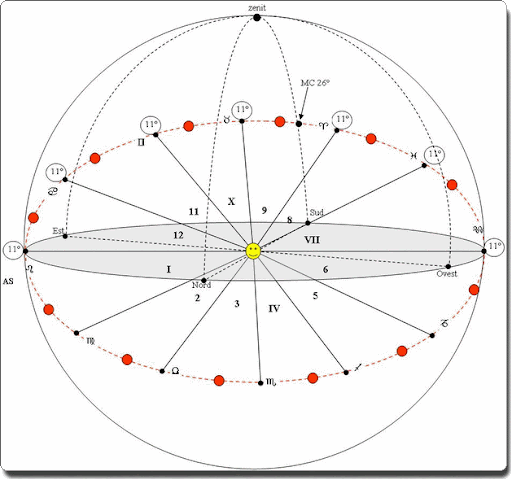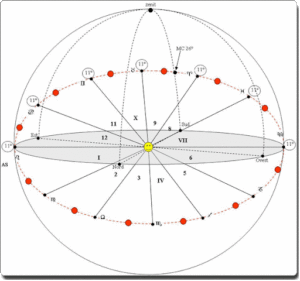
The domification method “Placido” is based on diurnal motion, that is the apparent motion of the celestial sphere in 24 hours, observed from a specific place on the Earth, and on temporal hours.
TEMPORAL HOURS
The temporal hour is obtained by dividing the daytime arc of the sun (from rising to sunset) and the night arc (from sunset to the next sunrise) into twelve parts.
The solar temporal hour will be 60 minutes only during the two days of the Spring and Autumn equinoxes. In these two days the Sun travels, in its diurnal motion, the full Celestial Equator. For this reason the 60 minute hour is called equinoctial hour.
60 minute hour = equinoctial hour
From the spring equinox to the autumn equinox the day time will be greater than 60 minutes (in our hemisphere, the Sun has a Northern declination), from the autumn equinox to the spring equinox the time day time will be less than 60 minutes (in our hemisphere, the Sun has a Southern declination ).
We must remember that the measured times are relative to the ascension of the ecliptic degrees and of those stars which, in their diurnal motion, describe a diurnal arc and a nocturnal arc.
Ecliptic = the great circle that is the path of the Sun among the constellations in the course of a year.
So the temporal hour will always be 1/12 of the daytime arc (diurnal temporal hour) and 1/12 of the nocturnal arc (nighttime temporal hour) and can be calculated for everything that rises and sets.
Temporal hour = 1/12 of the daytime arc or 1/12 of the nocturnal arc
WARNING: everything that always remains visible (circumpolar) or invisible (anticircumpolar) cannot be classified in the Placido domification!
The inclination of the ecliptic with respect to the local horizon varies with geographical latitude. Furthermore, the times of ascension of the ecliptic degrees vary, due to the inclination of the ecliptic circle with respect to the celestial equator; this is why the Placido method is particularly sensitive to the latitude of the location of the event.
First of all it is necessary to identify the Medium Coeli — M.C. (the higher culminating ecliptic degree), and then you can find the ascending ecliptic degree, which is always be 6 temporal hours away from the local meridian.
Ascending ecliptic degree = 6 temporal hours away from the local meridian
The cusp of the 12th field will be the degree of the ecliptic which, on its hourly circle, will have traveled 2 temporal hours of the 6 that lead it from rising to the Meridian.
The cusp of the 11th field will be the degree of the ecliptic which, on its hourly circle, will have traveled 4 of the 6 temporal hours that lead it from rising to the Meridian.
The same goes for the cusps of the 2nd and 3rd fields, regarding the time they take to pass from counterculmination or Imum Coeli (I.C.) to the horizon.
The cusps of the remaining houses are obtained in the diametrical position to those described.
It must be added that the domified space above the horizon relative to 5° equatorial is added to the first house. This part of the twelfth house is actually the place where the planets, although physically located in the twelfth house, direct their influences on the Ascendant. This principle is valid for all sectors of domification.
CONCLUSION AND COMMENTS:
Placido Domification divides into sectors or houses that part of the celestial sphere in which the parallels of declination present a diurnal arc and a nocturnal arc. This method has a prevalence of the time factor.
There are many misunderstandings among those astrologers who have not well understood the nature of Placido domification: the ecliptic aspects of the planets with the Ascendant and the Midheaven (MC). As we have seen, the nature of the division of the local sphere into sectors is linked to the circles of hours, and these are linked to the times of ascension and declination of the stars and the ecliptic degrees.
The structure of Placidus domification is therefore Time.
The cusps and the position of the stars in the sectors or houses indicate how much time it takes or has passed since the transit of that star or that ecliptic degree (cusp) on the local meridian. The ecliptic position (longitude and latitude) of the stars is a factor relating to Space.
Giulia Maria Miscioscia

